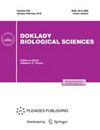基于毒力试验和SSR标记的2023年俄罗斯黄锈病群体结构分析
摘要
小麦黄锈病是由小麦纹状锈病(Pst)引起的,其严重程度在过去几十年中在世界范围内有所增加。这项工作的目的是表征2023年俄罗斯Pst群体的毒力和分子多态性。在西北地区(列宁格勒州)、北高加索地区(达吉斯坦和克拉斯诺达尔边疆区)和下伏尔加河地区(萨拉托夫州)采集了含有Pst urediniopuules的叶子。以14个等基因系(AvocetNIL)和15个分化品种作为毒力试验材料。微卫星分析采用了全球锈病参考中心推荐的20种标记物。SCAR标记(SCP19M: 24a1, 24a2, 26a1和26a2)参与了对侵袭性小种PstS1和PstS2的搜索。毒力分析包括70株分离株:34株来自达吉斯坦,12株来自克拉斯诺达尔地区,6株来自萨拉托夫州,18株来自列宁格勒州。其中Yr5、Yr10、Yr15、Yr24、Yr26效率较高。先前在俄罗斯有效的Yr17基因的毒力有所增加。其他Yr基因的毒力频率未见显著变化。与2019-2022年相似,2023年Pst区域种群表型多样性较高。共检测到45种表型(种),其中达吉斯坦23种,克拉斯诺达尔3种,萨拉托夫2种,列宁格勒17种。在克拉斯诺达尔和列宁格勒疫区观察到两种常见的毒力表型。根据f1指数,达吉斯坦、克拉斯诺达尔和列宁格勒人口高度相似,而萨拉托夫人口与它们有中度分化。微卫星分析包括55株分离株(达吉斯坦28株、列宁格勒18株、克拉斯诺达尔6株和萨拉托夫3株)。20个基因座中有10个是多态的,每个有两个等位基因。11个位点显著偏离Hardy-Weinberg平衡。微卫星基因座测定的地理种群基因型多样性低于毒力测定。共检测到20个多位点基因型(mg),其中达吉斯坦14个,列宁格勒7个,克拉斯诺达尔2个,萨拉托夫1个。在达吉斯坦,克拉斯诺达尔和列宁格勒的收藏品(MG_1)中发现了常见的mg;达吉斯坦和列宁格勒收藏品(MG_2);以及达吉斯坦和萨拉托夫系列(MG_3)。在至少两个分离株中分别观察到3 mg (MG_4-MG_6);其他的,在一个单独的。在毒力分析中,达吉斯坦、克拉斯诺达尔和列宁格勒群体在SSR标记(Fst指数)上高度相似,萨拉托夫群体差异中等。Mantel试验显示,毒力与微卫星结果高度相关(r = 0.93)。利用SCAR标记,与往年一样,在列宁格勒和达吉斯坦人群中发现了单个PstS2分离株。因此,在联合分析中建立了俄罗斯黄锈病群体的高变变性,有必要每年对其毒力多态性和SSR位点进行研究。推荐使用高效Yr基因供体进行抗黄锈育种。北高加索和西北Pst样本之间缺乏差异,表明该地区存在单一种群。The severity of wheat yellow rust, which is caused by Puccinia striiformis f. sp. tritici (Pst), has increased worldwide in the past decades. The aim of this work was to characterize the virulence and molecular polymorphism of Russian Pst populations in 2023. Leaves with Pst urediniopustules were collected in the Northwestern (Leningrad oblast), North Caucasian (Dagestan and Krasnodar Krai) and Lower Volga (Saratov oblast) regions. Fourteen isogenic lines (AvocetNIL) and 15 differentiator varieties served as virulence testers. Twenty markers recommended by the Global Rust Reference Center were used in microsatellite analysis. SCAR markers (SCP19M: 24a1, 24a2, 26a1, and 26a2) were involved to a search for the invasive races PstS1 and PstS2. Virulence analysis included 70 isolates: 34 from Dagestan, 12 from Krasnodar Krai, 6 from Saratov oblast, and 18 from Leningrad oblast. The genes Yr5, Yr10, Yr15, Yr24, and Yr26 showed a high efficiency. An increase in virulence was noted for the Yr17 gene, which was previously efficient in Russia. No significant changes in virulence frequencies were detected for the other Yr genes. High phenotypic diversity was characteristic of the regional Pst populations in 2023, like in 2019-2022. In total, 45 phenotypes (races) were detected (23 in the Dagestan, 3 in the Krasnodar, 2 in the Saratov, and 17 in the Leningrad collection). Two common virulence phenotypes were observed in the Krasnodar and Leningrad Pst collections. According to the Fst index, the Dagestan, Krasnodar, and Leningrad populations were highly similar, while the Saratov population was moderately differentiated from them. Microsatellite analysis included 55 (28 Dagestan, 18 Leningrad, 6 Krasnodar, and 3 Saratov) isolates. Ten out of 20 loci were found to be polymorphic, each having two alleles. Significant deviations from the Hardy-Weinberg equilibrium were observed for 11 loci. Genotypic diversity of the geographic populations by microsatellite loci was lower than by virulence tests. Twenty multilocus genotypes (MGs) were detected in total (14 in the Dagestan, 7 in the Leningrad, 2 in the Krasnodar, and 1 in the Saratov collection). Common MGs were found in the Dagestan, Krasnodar, and Leningrad Pst collections (MG_1); the Dagestan and Leningrad collections (MG_2); and the Dagestan and Saratov collections (MG_3). Three MGs (MG_4-MG_6) were each observed in at least two isolates; the others, in a single isolate. As in the virulence analysis, the Dagestan, Krasnodar, and Leningrad populations were highly similar in SSR markers (Fst index), and the Saratov population differed moderately. Mantel's test showed a high correlation between the virulence and microsatellite results (r = 0.93). Using the SCAR markers, single PstS2 isolates of were identified in the Leningrad and Dagestan populations, like in previous years. A high variability of the Russian yellow rust populations was thus established in the combined analysis, warranting annual studies of their polymorphism for virulence and the SSR loci. Donors of highly efficient Yr genes were recommended to use in breeding for yellow rust resistance. Lack of differentiation between the North Caucasian and Northwestern Pst samples indicates that a single population occurs in the regions.

 求助内容:
求助内容: 应助结果提醒方式:
应助结果提醒方式:


